The Pomeranian Husky Mix, also known as a Pomsky, has a reputation as one of the designer dog breeds. As its name suggests, it’s a cross between a Pomeranian and a Siberian Husky
I remember the first time I met a Pomsky. I was walking through the park, and there, trotting towards me with an air of confidence was a small, fluffy dog with striking blue eyes. “She’s beautiful. What breed is she?” I asked the owner. “She’s a Pomsky. Half Husky, half Pomeranian.” The owner replied as the dog, Luna, looked up at me with a playful gaze. “She thinks she’s a big guard dog,” the owner chuckled, watching Luna attempt to intimidate a passing butterfly. “But really, she’s all bark and a lot of fluff!”
If you’d like such a breed, full of charm and playful spirit, keep reading to find out the most suitable home for it.
TABLE OF CONTENTS
- Pomeranian Husky Mix Quick Summary
- Pomeranian Husky Mix Parent Breeds
- Pomeranian Husky Mix Physical Characteristics
- Pomeranian Husky Mix Personality and Temperament
- Pom Husky Mix Care Guide
- Pom Husky Mix Health Issues
- Pomeranian Husky Mix Puppies
- FAQs about Pomeranian Husky Mix
- An Absolute Gem for First-timers
- Other Husky and Pomeranian Mixes
Pomeranian Husky Mix Quick Summary
Pomeranian Husky Mix Parent Breeds
From Adobe Stock
The Pomeranian Husky Mix has inherited its energetic personality traits from its historically working parent, the Husky, and its desire for love and attention from the Pomeranian. This has resulted in an energetic, playful, and intelligent but also loving companion dog breed that is easy to fall in love with.
Kennel Club Recognition
Because this is a very recent dog and is a mix of two purebred canines, the American Kennel Club doesn’t recognize the Husky Pomeranian as a purebred. It is unlikely a Kennel Club ever will recognize it in these dog breeds’ current form, as there is no consistency in personality traits, temperament, and appearance to set a breed standard.
There are however a few clubs that offer information about these dog breeds:
- Dog Registry of America
- Pomsky Club of America
- International Pomsky Association
Because of a lack of approved reputable breeder standards, which are typically set by Kennel Clubs, if you already have your eyes set on this beautiful Pomeranian Husky mix you will have to do your research to find a good breeder.
Let’s first discuss the parent breeds before looking at the characteristics of the mix.
Pomeranian
Origin
The Pomeranian, often affectionately called a “Pom,” originates from the Pomerania region in Central Europe, now part of Poland and Germany. Historically, they were much larger dogs used for herding sheep and protecting livestock. It’s fascinating to think about how these small dogs we see today were once hardworking herders. I found that through selective breeding, they were downsized to become the beloved lapdogs of royalty and nobility across Europe in the 18th Century. Queen Victoria of England had a particularly strong affection for Pomeranians, which significantly contributed to their popularity.
Physical Characteristics
Pomeranians are known for their fluffy double coats, fox-like faces, and lively expressions. They typically weigh between 3 to 7 pounds, making them one of the smallest dog breeds. Despite their small size, I always remind people that Pomeranians have a big-dog attitude, often unaware of their diminutive stature. Their coat comes in a wide variety of colors, including orange, black, white, cream, blue, and sable. Their thick fur requires regular grooming to prevent matting and maintain their distinctive, puffy appearance. Their small, erect ears and bright, curious eyes give them an alert and intelligent expression, which accurately reflects their perceptive nature.
Temperament and Behavior
Pomeranians are known for their spirited and bold personalities. They’re incredibly loyal to their families, often forming a strong bond with a specific person. I’ve seen firsthand how Poms can be quite protective of their owners, despite their small size. They’re also very intelligent and responsive to training, although their independent streak can sometimes present a challenge. Early socialization and consistent, positive reinforcement training methods are key to nurturing their best qualities.
Pomeranians have a high energy level for their size and enjoy regular playtimes and short walks. However, they’re also well-suited to apartment living, as long as they get enough daily exercise to keep them happy and healthy. It’s important to remember that their small size doesn’t mean they don’t need exercise and stimulation; a bored Pom can develop unwanted behaviors. Their vocal nature makes them excellent watchdogs, alerting their family to anything unusual, but it’s crucial to manage this trait so it doesn’t turn into excessive barking.
Siberian Husky
Origin
The Siberian Husky is a breed with a rich history that dates back over a thousand years, originally bred by the Chukchi people in Siberia. These dogs were designed to pull sleds over long distances, which explains their remarkable endurance and strength. It’s quite inspiring to learn about their vital role in the survival of the Chukchi tribes, helping them transport goods across the vast, frozen landscapes. I found out recently that the Siberian Huskies were introduced to Alaska in the early 20th Century, where they gained fame during the Nome Serum Run of 1925, delivering lifesaving diphtheria serum across harsh winter conditions. This event not only highlighted their incredible stamina and resilience but also cemented their status as beloved and capable working dogs around the world.
Physical Characteristics
Siberian Huskies are medium-sized dogs, known for their striking appearance and wolf-like features. They typically weigh between 35 to 60 pounds, with a dense double coat that keeps them insulated against extreme cold. Their coat colors vary widely, including shades of black, grey, red, and pure white, often with distinctive markings on the face and body. One of the most captivating traits of Huskies is their eyes, which can be blue, brown, or even one of each—a condition known as heterochromia. Their erect ears and bushy tails add to their alert and agile appearance. Despite their heavy coat, Huskies require surprisingly minimal grooming outside of shedding seasons, thanks to their self-cleaning fur. It’s always a pleasure to see them in action, their graceful movement reflecting their athletic build and boundless energy.
Temperament and Behavior
Siberian Huskies are renowned for their friendly and outgoing nature. They are incredibly social dogs, enjoying the company of both humans and other dogs. Their friendly demeanor means they’re usually not the best watchdogs, as they’re more likely to welcome strangers than guard against them. I always advise potential Husky owners about their need for companionship; these dogs thrive in the presence of their families and can become unhappy if left alone for long periods. Their intelligence and independent spirit can be both a joy and a challenge. Training a Husky requires patience, consistency, and a sense of humor, as they’re known for their playful disobedience and clever escape tactics. Exercise is crucial for this breed; they need plenty of it to maintain their mental and physical health. A bored Husky can be quite inventive in finding ways to entertain themselves, often leading to unwanted behaviors. Their history as sled dogs means they have a strong prey drive and love to run, making secure, fenced yards and leashed walks essential for their safety. Despite these challenges, living with a Husky can be incredibly rewarding, as they bring joy, laughter, and an adventurous spirit into their families’ lives.
Pomeranian Husky Mix Physical Characteristics
From Adobe Stock
I’ve noticed that the Pomeranian Husky Mix can come in so many different colors and patterns because their size depends on their parents. If they have more Husky they will be larger and heavier but more Pomeranian will result in a smaller and lighter pooch.
Height and Weight
Let’s talk about the size of these adorable Pomskies! Generally, they stand about 10 to 15 inches tall. As for weight, they’re on the lighter side, tipping the scales at 15 to 30 pounds. But, have you heard about the teacup version? These little guys are even tinier, standing just 7 to 10 inches tall and weighing in at a featherlight 5 to 10 pounds. Honestly, if you’re trying to guess how big your Pomsky will get, look at the sizes of their mom and dad.
Appearance
Now, onto why the Pomsky hasn’t snagged a spot in the major Kennel clubs—it’s all about their looks, or rather, how varied they can be. It’s tough to settle for a breed standard when no two Pomskies are exactly alike. But that’s part of their charm, right? Generally, they have the Husky’s facial features and the size of a Pom. Imagine tiny, fluffy wolves, and you’re on the right track. They also inherit lush double coats and a signature curled tail. Super cute!
Color
From Adobe Stock
The color palette of a Pomsky is nothing short of impressive. We’re talking black, blue, brindle, brown, cream, merle, orange, red, tan, and white. It’s like a rainbow of options! And just like their coat colors, their eyes can dazzle you with variety—classic Husky blue, warm Pomeranian brown, or even one of each for that extra wow factor. The merle coat pattern, in particular, is stunning.
Coat
When it comes to their coat, Pomskies take after their parents. Expect some shedding from their thick, fluffy double coats. It’s a moderate amount, so a good brush now and then should keep the fluff at bay. Their outer coat might feel silky and smooth like a Husky’s or have that fluffy Pomeranian texture. Either way, they’re always ready for a cuddle session. Just remember, that luxurious coat is part of what makes them so special, shedding and all!
Pomeranian Husky Mix Personality and Temperament
From Adobe Stock
The Pomsky mix is a real charmer, inheriting a strong sense of loyalty from their Pomeranian side. They love attention, and let me tell you, they know exactly how to get it—often with their distinctive barking. It’s worth noting that their bark is not just loud but has a high pitch to it. For anyone living in tight city quarters, this might be something to consider, as their vocal expressions could be a bit much for neighbors.
I’ve noticed that a well-socialized and trained Pomky Husky doesn’t show aggression. These dogs are incredibly loyal and won’t hesitate to stand their ground when they feel their family or territory is threatened, despite their small size. Speaking of size, they might indeed feel more threatened in certain situations compared to larger breeds, but with the right support, they often navigate these moments bravely.
One thing I’ve always admired about the Pomsky is their zest for life. They’re always up for a play session in the yard and make fantastic companions. They genuinely enjoy being around their human family, happily tagging along wherever you go. But don’t let their cute looks deceive you; these little guys have heaps of personality and independence. Without consistent training, they can become a bit stubborn, believing they’re the boss.
Compatibility with Families
As for fitting into family life, Pomskies are great. They’re as happy to chill out with you as they are to engage in play. However, without early socialization, there’s a risk they could develop small dog syndrome, becoming overly protective and snappy with strangers. That’s why introducing them to a variety of people, dogs, and situations from a young age is crucial.
In my conversations with fellow dog enthusiasts, it’s clear that a Pomsky that grows up with children or other pets and is properly socialized will be more adept at interacting and playing gently. A well-socialized Pomsky, especially one from a reputable breeder, will joyfully engage with both kids and other dogs, making it a delightful addition to nearly any family.
Pom Husky Mix Care Guide
From Adobe Stock
Playing is a great way to exercise and bond with your Pomeranian Husky dog. That’s one of the things I noted with the Pom Husky I saw at the park. Its owner would come to the park several times a week. Here are care needs you should never ignore.
Feeding
Picking a high-quality food tailored for small breeds is crucial. Look for formulas rich in animal protein and fats, with limited carbohydrates. This composition helps meet the high energy demands of this active breed, ensuring they get all the essential nutrients for a healthy life.
For an active Pomsky weighing between 20 to 30 pounds, the general guideline is about 30 calories per pound of body weight daily. So, a 20-pound Pomsky would need around 600 calories a day, equating to roughly 2.5 cups of food, depending on the food’s calorie content. Always adjust the amount based on your dog’s weight, age, and activity level to prevent obesity and related health issues like hip dysplasia. In addition, ensure your Pomsky has access to fresh, clean water. Hydration is crucial for their overall health, aiding in digestion, nutrient absorption, and maintaining healthy skin and coat.
Some Pomskies might have specific dietary needs due to health issues like allergies or sensitivities. In such cases, consult your veterinarian for a diet plan that suits their needs, possibly including hypoallergenic or prescription diets.
When changing your Pomsky’s diet, it’s important to transition slowly over about a week. Start by mixing a small amount of the new food with their current food, gradually increasing the new food’s proportion. This gradual change helps prevent digestive issues and helps your dog adjust to the new taste and texture.
Feeding Through Life Stages
Puppies
Pomsky puppies are little balls of energy and have different nutritional requirements than adults. They need more calories and protein to support their rapid growth and development. I suggest you feed them puppy-specific food three to four times a day, following the recommended serving sizes based on their weight and age. This frequent feeding helps support their metabolism and growth needs.
Adults
As they mature, transitioning to adult food should be done gradually to avoid upsetting their stomach. An adult Pomsky’s diet should still be rich in high-quality protein and fats but adjusted for their less intense growth energy needs. Typically, feeding them twice a day works well, keeping an eye on portion sizes to maintain a healthy weight.
Seniors
Senior Pomskies might have slower metabolisms and less energy, requiring fewer calories. However, they still need nutrient-rich food, especially those that support joint health and digestion. Monitor their weight and adjust their diet as needed, considering any special dietary needs based on their health.
Grooming Needs
Grooming a Pomsky isn’t just about keeping them looking cute (though that’s a perk); it’s also about keeping them healthy. Let’s dive into some grooming essentials that I’ve come to understand are pretty important for these fluffy buddies.
Brushing
Okay, let’s talk about their fur first. Pomskies have this gorgeous thick coat that, while super cuddly, does need regular brushing. A couple of times a week should do the trick to keep shedding manageable and avoid any mats or tangles from forming. I’ve learned that using tools like a de-shedding brush or a slicker brush can help get through that fluffy undercoat.
Bathing
Now, for baths, Pomskies are pretty low maintenance. They don’t need to be bathed very often, which is great news for anyone who doesn’t fancy wrestling a dog into a bathtub regularly. Every couple of months is fine unless they decide to roll in something smelly. When it’s bath time, picking a gentle dog shampoo will keep their skin from drying out.
Nail Trimming
Nail trimming can be a bit tricky, especially if your Pomsky isn’t a fan of having their paws handled. Keeping their nails short is crucial, though, because long nails can lead to discomfort and even affect their walking. Aim to trim them every few weeks or so. If you’re not comfortable doing it yourself, it’s okay to get a groomer or vet to help out.
Ear Cleaning
Ears are another spot to keep an eye on since wax and debris can build up and lead to infections. Cleaning their ears gently with a dog-approved ear cleaner every few weeks can keep them healthy. It’s one of those things that might seem a bit daunting at first, but once you maintain a routine, you’ll not have a problem.
Dental Care
Dental health is important, too. Brushing their teeth a few times a week with dog-specific toothpaste can help prevent dental problems down the line. And if your Pomsky is anything like the ones I’ve seen, they’ll love the taste of the toothpaste. Dental chews are also great for keeping their teeth clean and giving them a bit of a gum workout.
Training and Exercise
Training and exercising a Pomsky is not just about keeping them physically fit; it’s also about building a strong bond between you and your fluffy friend. From my journey with these spirited dogs, I’ve picked up some insights that might help make this journey a bit smoother for both of you.
Exercise
Their Husky half was bred to work so even though the Pomeranian x Husky might look small; they still need exercising every day. However, because of their small size, the Pomeranian Husky doesn’t need intense exercise like larger dogs. Just playing with them in the garden can be enough and will help strengthen your bond.
But like all dogs, Pomeranian Huskies love to get out and about, discovering new sights and smells. Therefore, try walking your Pomeranian Husky Mix for 30 minutes per day, and if they still seem a little too hyper add some fun play at the end of the day.
Training
With two intelligent parents, and being major show-offs, you shouldn’t have any trouble training your Pomeranian Husky pet. However, they can have a stubborn streak, so this designer dog breed requires a strong-willed owner who is patient and can teach them how to be well-balanced dogs.
I find that with lots of positive acknowledgment, they are eager to please and are happy to learn new tricks as long as they get a treat along the way. On top of that, early training and socializing is always the best way to get the most out of your Pomeranian Husky dog, start with basic house rules like no jumping up.
Mental Needs
Mental stimulation is just as important as physical exercise for a Pomsky. These dogs love to learn and be challenged. Puzzle toys and games that make them think are perfect for keeping their minds sharp. Even simple things like hiding treats around the house can turn into a fun game. It’s amazing how something so simple can keep them entertained and mentally engaged.
Socialization
Socialization is crucial, especially from a young age. Introducing your Pomsky to different people, animals, and environments can help them grow into well-rounded and confident adults. It helps prevent any fear or aggression towards new experiences. Puppy classes are great, not just for socialization, but also for starting their training off on the right foot.
Pom Husky Mix Health Issues
From Adobe Stock
Many people believe that crossbred dogs (i.e. designer dogs) are healthier than purebreds because of the larger gene pool. However, if both parents are particularly prone to contracting specific health issues, their puppies still have a high chance of inheriting them too.
Luckily, the Siberian Husky and the Pomeranian are relatively healthy breeds. However, there are some health problems that this designer breed can develop and that you need to know:
Dilated Cardiomyopathy
Dilated Cardiomyopathy is something I’ve learned you have to watch out for in dogs, especially in certain mixes like the Pomsky. It’s a heart condition where the heart becomes enlarged and can’t pump blood as effectively. Symptoms can sneak up on you, including breathing difficulties, coughing, a noticeable loss of appetite, and general weakness. It’s a condition that progresses quickly and can be quite serious. From what I’ve seen, staying vigilant and catching these signs early can make a big difference in managing the condition and keeping your furry friend comfortable.
Eye Problems
Eye issues are also something Pomsky owners should be on the lookout for. Entropion is one condition I’ve seen in Huskies, that causes the eyelids to roll inward, which can be quite uncomfortable for a dog. It’s hereditary and tends to get worse over time if left untreated. Symptoms like eye irritation, squinting, and visible discomfort should prompt a visit to the vet. Early detection and treatment can help manage this condition and prevent further complications.
Dental Issues and Ear Infections
Dental problems and ear infections are fairly common in Pomskies, but they’re also largely preventable. Regular dental care, like brushing and dental chews, can help ward off dental issues. As for ear infections, keeping their ears clean and dry is key. These issues might seem minor, but they can lead to more serious problems if ignored. I always remind fellow dog lovers that a little prevention goes a long way in keeping their pets healthy and happy.
Hip Dysplasia
It’s a genetic condition where the hip joint doesn’t fit together perfectly, which can lead to arthritis or mobility issues. Watching for signs of discomfort when your dog is walking, running, or getting up can help catch this issue early. While genetics play a big role, maintaining a healthy weight and regular exercise can help manage the symptoms and keep your dog active.
Collapsing Trachea
Symptoms include a honking cough, difficulty breathing, and gums that turn gray or blue. Seeing your dog struggle to breathe can be alarming, and it’s something that needs immediate veterinary attention. This condition can be managed with medication and lifestyle adjustments, ensuring your Pomsky can have a good quality of life despite the diagnosis.
Pomeranian Husky Mix Puppies
From Adobe Stock
I’ve learned that the adorable Pomsky puppy is one of the most expensive designer breeds in the world. This expensive price tag (sometimes exceeding $3,000 per puppy) comes from the need to artificially inseminate the Pomeranian to create this mix.
Teacup dogs are cheaper to purchase, but it is strongly advised not to purchase them unless you can make sure that they’re from a reputable dealer, as they often come from puppy mills and can inherit serious medical issues due to poor breeding.
It is more common to find the Husky as the dam (i.e. mother) because it is easier for the larger-sized dog breed to carry a litter. Litter sizes are generally between 5 and 7 puppies. The weight and size of a Husky Pomeranian Mix can also vary depending on which parent they take after. However, a Pomsky puppy usually reaches maturity in one year, so you can expect them to be full-grown by their first birthday.
FAQs about Pomeranian Husky Mix
Does the Pomeranian Husky remain small?
Yes, the Pomeranian Husky mix tends to stay on the smaller side throughout its life. However, their final size can vary quite a bit due to the mix of their parent breeds. Some Pomskies lean more towards the Pomeranian side and stay around 15 pounds, while others can grow a bit larger, reaching over 30 pounds. It’s one of the charming uncertainties of mixed breeds.
How long does the Pomeranian Husky live?
The expected lifespan of a Pomeranian Husky is 12 – 15 years. This is based on the average age of the puppy’s parent breeds. But if you choose a healthy Pomsky puppy from a reputable breeder and make sure that it’s happy and healthy throughout its life, it could live longer.
How big is a full-grown Pomeranian Husky?
A full-grown Pomeranian Husky is generally a medium-sized dog. Its size is inherited from its parents so can be between the size of a Siberian Husky and a Pomeranian. The standard length of a fully-grown Pomeranian Husky is around 13 to 18 inches, weighing between 20 to 30 pounds.
Can Pomskies adapt to apartment living?
Yes, Pomskies can adapt quite well to apartment living as long as they get enough exercise and mental stimulation. Despite their energetic nature, they’re small enough to fit comfortably in smaller spaces. Just remember, daily walks and play sessions are crucial to keep them happy and healthy in a more confined space.
Are Pomskies good with children?
Pomskies can be great companions for children, especially when socialized from a young age. They inherit the playful and friendly nature of both Pomeranian and Husky parents. However, like with any dog, interactions with young children should be supervised to ensure the safety of both the child and the dog.
Do Pomskies require a lot of grooming?
Yes, due to their thick double coats, Pomskies do require regular grooming. This includes frequent brushing to reduce shedding and prevent matting, as well as the occasional bath. Keeping up with their grooming needs not only keeps them looking their best but also helps prevent skin issues.
How trainable are Pomskies?
Pomskies are quite intelligent and can be very trainable with the right approach. They respond best to positive reinforcement techniques such as treats and praise. Consistency and patience are key, as their Husky heritage can sometimes introduce a stubborn streak. Early and ongoing training helps positively harness their intelligence.
What are the exercise needs of a Pomsky?
Pomskies are active and energetic dogs that require regular exercise to stay healthy and prevent boredom. A mix of physical activities, like walks and play sessions, along with mental stimulation, such as puzzle toys, is ideal. They don’t need as much exercise as a purebred Husky but more than a typical Pomeranian.
An Absolute Gem for First-timers
I’ve always admired how these small but mighty companions adapt so well to various living situations. Their compact size is perfect for apartment living, yet they’ve got enough spunk and playfulness to fill a home with joy, making them fantastic companions for families too.
But let me tell you, despite their size, these dogs pack a punch in terms of personality and zest for life. They’re the kind of pets that bring a lot of energy and fun into your days because Pomskies are incredibly affectionate. They thrive on love and praise, and honestly, showering them with attention is one of the most rewarding parts of having one around. In addition, Pomskies are natural show-offs who love learning new tricks. It’s impressive how quickly they can pick up on commands, making training sessions both fun and a fantastic way to strengthen your connection.
Don’t be fooled by their petite stature; these little dynamos need their daily dose of exercise. I encourage pet owners to carve out at least half an hour each day for some active playtime or a walk.
Please share your experiences with this breed below.
Other Husky and Pomeranian Mixes
If you’re interested in learning about other Husky mixes or Pomeranian mixes, check out the hybrid dog breeds below.
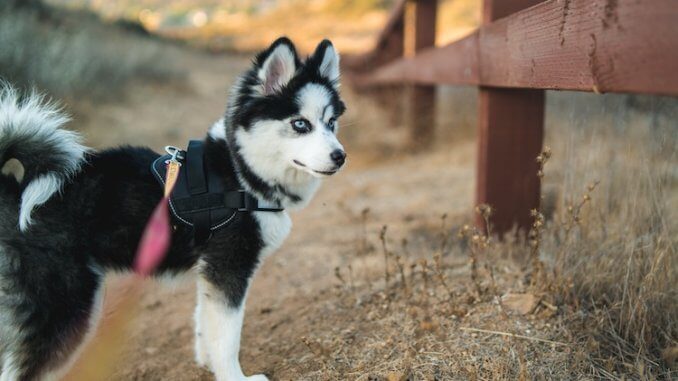
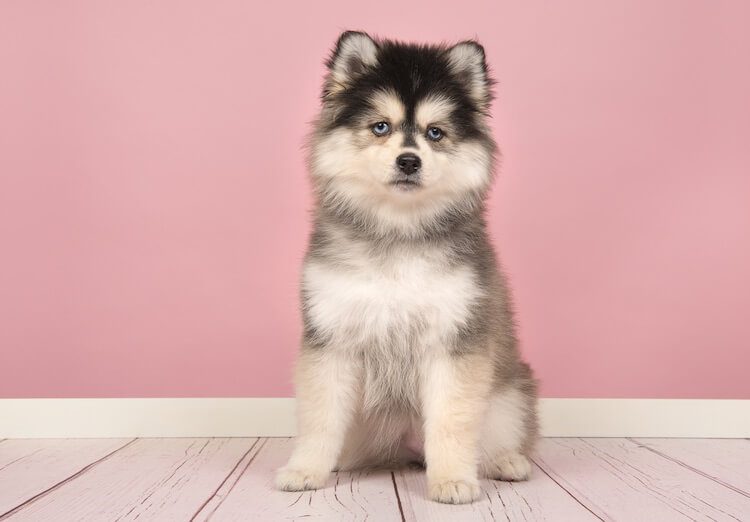
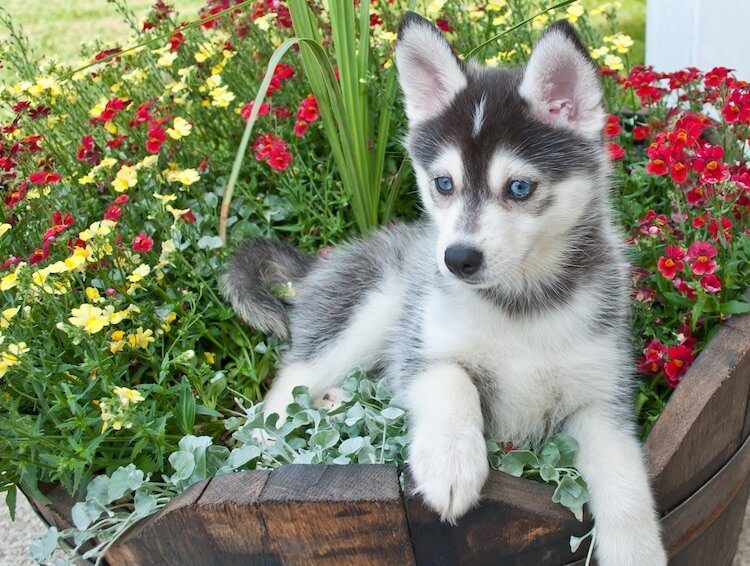
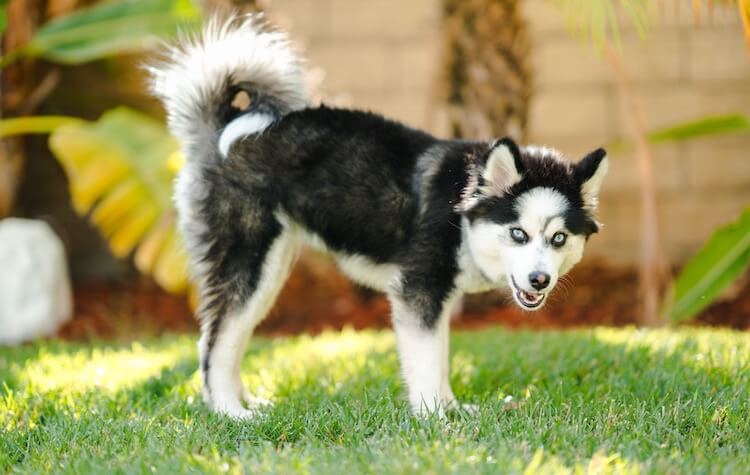

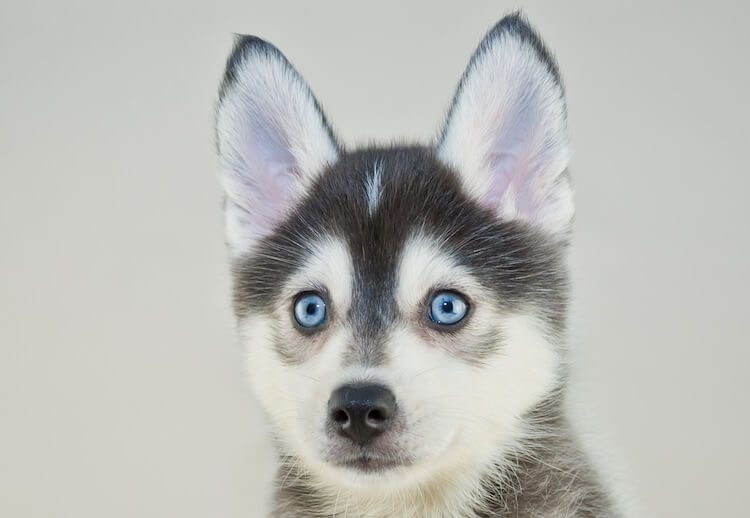
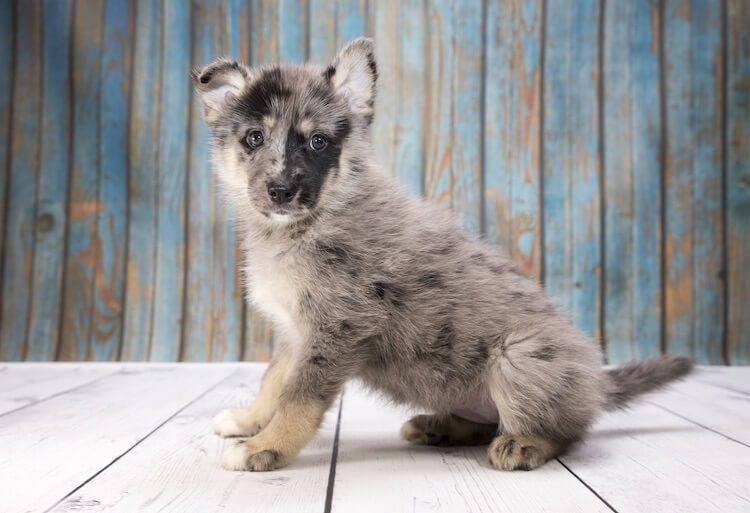
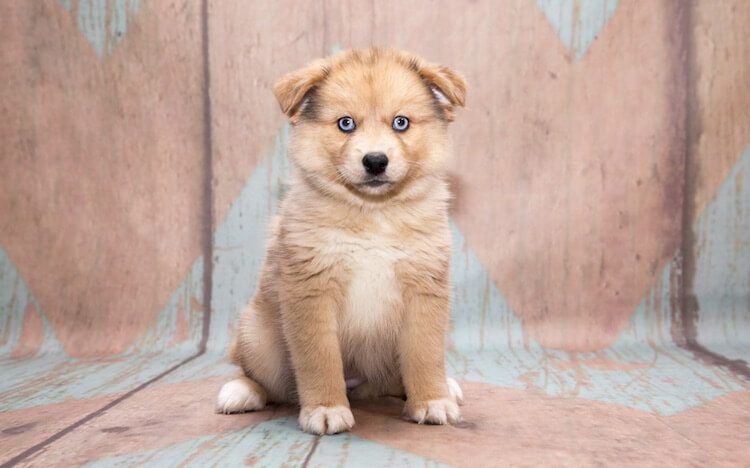

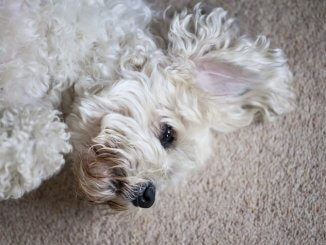


Thank you! You information given was very clear, very readable, and realistic to follow. I currently have a rescued Pom I have had for 4 years now. She couldn’t snuggle, was VERY aggressive and did not want to be touched at all. We are now close friends and she plus, snuggles, listens (mostly) to simple commands and can socialize with other dogs most of the time with proper introduction. Anyway, I don’t usually write to authors but like I said I really enjoyed your article and will most likely seek more of your work!
You did a great job describing the Pomsky breed. We had a Pomeranian who recently passed away from cardiac complications at the age of 12.5 years. He was bright loving and a lot of fun. We now have a 6 month old Pomsky. We have had him 2.5 months. He is also love-able and bright. He was easily crate and house trained within a few weeks. He learned sit, stay, give me your paw and down (briefly). He is learning to walk on a leash without pulling. He loves to play fetch. We miss our sweet Pom but have found another sweet pet in our Pomsky puppy. We are both retired and enjoy having a dog.
Hi Dottie,
I was wondering if you are able to tell me where you found your Pomsky Puppy? Did you find a Breeder, and if so, would you be willing to share that information with me. I would greatly appreciate it!
I would like to know how can I buy a puppy of this breed?